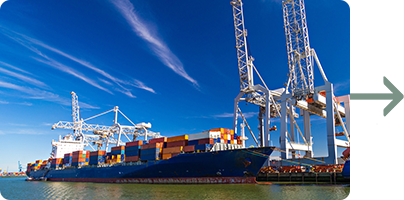Unique Logistics Solutions to Complex Container Drayage Issues
Today, more than 80% of global shipping involves containers. They're packed with everything from personal storage items in dry containers to heavy machinery on flat rack containers. For business owners shipping products, getting a container from point A to point B requires precise planning and high-level tracking. But that's easier said than done when global supply chains become over-congested, leading to loading time issues and delays.
That's bad news for business owners who are already under a massive amount of stress. The truth is that container storage delays can cripple a business, but there's a viable solution: drayage brokers in Charleston, SC like RelyEx. Drayage companies provide unique solutions to minimize demurrage and help ensure the successful delivery of your freight.
With more than 30 combined years of experience and a solutions-oriented team, RelyEx has quickly become the first choice for streamlined, efficient drayage services. To understand the true value of RelyEx's offerings in the global logistics industry, it helps to understand first what drayage is and why it's used.
What is Drayage and Why Is It Important?
If you're a seasoned business owner who uses port drayage to transport your products, you know exactly how important the service can be. But if you were to poll a group of random people, you may get five different definitions of the term "drayage." That begs the question, how is one of the most crucial steps in the supply chain and most vital components of global trade such a confusing concept? When you break it down, it's not too difficult to grasp.
Drayage, by definition, means the transportation of freight from an ocean port to another destination. Today, drayage is also used to describe the process of transporting products and goods over short distances or over "the first mile."
While drayage often means short-distance movements during the supply chain process, it's primarily used in the container shipping space. Drayage loads usually have arrival and departure points in the same city and don't include long-haul, national transportation.
Let us know how we can help.
drayage broker Services
Service Areas
Because a drayage load can mean a few different things, confusion among carriers is common. Many carriers link drayage with going into a port, but that isn't always true. While all drayage loads typically originate from a port of entry, there are often several legs of a drayage journey before a container turns up at its final stop. Legs of a drayage load may include:
Why Are Drayage Companies in Charleston, SC So Important?
You may be thinking, what's so important about drayage? It's such a small step in the container storage transport process. In reality, it's an integral piece needed in the logistics industry and a crucial part of U.S. supply chain management.
To truly understand the importance of drayage, let's use flowers as an example. Most cut flower shipments enter the market from areas in South America until they end up at Dutch auction houses. Once there, wholesalers purchase flowers in bulk and send those products to retail outlets worldwide. Because flowers are perishable, they typically need to be refrigerated and are often shipped in reefer containers. These refrigerated vessels must maintain a certain temp to prevent loss.
Drayage companies like RelyEx allow flower shippers to send their products from Argentinian ports to airports in the Netherlands with peace of mind because their products are protected. The only way to accomplish this feat is with the help of swift, meticulous port drayage services. Drayage companies allow flower shippers to send their products from Argentinian ports to airports in the Netherlands with peace of mind, because their products are protected. The only way to accomplish this feat is with the help of swift, meticulous port drayage services.
If port drayage is compromised, it can cause delays and even fines. You know the packages you get delivered to your front door from apps like Amazon? Without drayage and drayage brokers, one or two-day shipping times wouldn't even be possible.
As a multi-billion-dollar industry in the U.S. alone, it seems like drayage shipping issues shouldn't exist. But the fact is inefficiencies and congestion are still major problems at ports. Whether it's a lack of carriers, absent chassis, or overburdened terminals, delays lead to missed deadlines, lost revenue, and worse.
But anytime challenges exist, so too do innovative solutions.
QUOTE REQUEST
Port

Yard

Warehouse

Rail

The RelyEx Difference
RelyEx was created because our founders saw a need in the logistics space for more reliability and efficiency. The reality of the shipping and logistics industry is that it has become very transactional. It's an odd evolution, because most businesses seek a third-party logistics partner that is accessible, transparent, and committed to providing solutions.
As the logistics space continues to grow, it creates newfound expenses and complexities. Clients like ours know that and need a supply chain partner who is genuinely interested in their business. By understanding the needs of our customers and carriers, we can provide the most reliable, effective drayage services possible.
Unlike some drayage companies in Charleston, SC, we begin managing your containers before they ever hit the ports by mapping out the most efficient pathways of delivery. That way, our team can discover the best drayage pathways to expedite delivery time and reduce fees that cut into profits.
Our valued drayage customers choose RelyEx because:

RelyEx Solves Problems
At RelyEx, we like to consider ourselves problem solvers. The nature of the container drayage industry presents new challenges every day, but we're firm believers that there's a solution to every hurdle we encounter. And while some drayage businesses implement a reactive approach, RelyEx customers choose us for our proactive mindset. We take pride in solving your company's drayage challenges to help you avoid frustrating fees, missed expectations, and delayed shipments. We strive to make every transaction successful and streamlined by partnering with shippers who prioritize transparent, prompt, and accurate communication.

RelyEx Has a Unique Vantage Point
RelyEx approaches your business from the customer's perspective - a unique approach that helps us provide high-quality, effective drayage services. We've been in the customers' shoes, know their pain points, and because of that, provide first-hand solutions to stressful supply chain issues. With over 30 years of collective knowledge, our team excels in:
- Inventory Management
- Logistics
- Purchasing
- Finance
Our varied, high-level drayage shipping experience helps us achieve our overarching goal: expertly managing your freight movement needs. That way, you can direct your time and focus on growing the core aspects of your business while we handle the heavy lifting. Throw in proactive planning to avoid bottleneck situations and strong communication for transparent customer relations, and you can see why so many companies trust RelyEx.

RelyEx Nurtures Strong Carrier Relationships
When it comes to shipping logistics, it only takes one mistake by a mediocre worker to disrupt your business. That's why, at RelyEx, we pride ourselves on forming and nurturing relationships with carriers who match our standards of care. Our founding partner started his career transporting freight for companies as an on-demand carrier. He uses that knowledge to maximize the resources of our carriers so that our customer's expectations aren't just met - they're exceeded.
Why Choose RelyEx as Your
Drayage Company in Charleston, SC?
Based in the port city of Charleston, RelyEx has a keen understanding of the challenges of managing the inbound and outbound flow of containers. Our team of container drayage experts provides your business with unique solutions to nuanced shipping problems, minimizing demurrage and ensuring the successful delivery of your freight.

Customers choose RelyEx because:
- We are a reliable drayage logistics partner that manages your freight from beginning to end
- We have a rare industry vantage point with 30+ years of client-side experience
- We foster and fortify the strongest vendor relations
- We take a proactive approach to problem-solving, not a reactive approach
Let us know how we can help.
 843-885-3082
843-885-3082

Your Drayage Shipments Managed from Start to Finish
Some drayage brokers don't care how customers feel about their service as long as they sign a contract and get paid. As a solutions-oriented team, RelyEx takes the opposite approach. We're motivated by the opportunity to overachieve for our customers and to provide them with the best logistics experience possible. With professional experience as carriers and shippers ourselves, we know the roadblocks and challenges you're facing. We excel at mapping out the best plans of action to solve those problems. But that's just the start.
Our tracking experts monitor and manage every aspect of your drayage shipment from booking to delivery, 24/7. Once booked, we look for the availability of your containers hourly once they're at port. When they arrive, our team acts quickly to access your storage containers when they're available.
Plus, RelyEx ensures your company's requirements are met by the carrier during loading and delivery and provide necessary documentation as fast as possible. With real-time tracking updates and access to our customer service professionals, your team has complete visibility throughout the shipping process.
We Source Top-Notch Operators at the Best Prices
Over the years, RelyEx has built a strong network of drayage carriers, transloading locations, and container storage spaces to provide you with the best possible options to match your drayage service needs. We know that searching for quality service presents an added layer of complexity and stress to our customers. That's why we work hard to take that off your plate by connecting you with our reliable shipping partners.
With a background moving freight as an on-demand carrier, our founding partner understands how to maximize the resources and equipment of our carriers to match your needs.


We Make Transparent, Timely Communication a Priority
Like other industries, the global logistics space is complex. Mistakes will be made, and problems will happen. With those truths in mind, RelyEx has built its reputation as problem solvers. Unlike other drayage companies, we don't shy away from this industry's complexities because we take pride in solving problems. Even better, we aim to do what's needed to avoid those problems altogether.
As your logistics partner, we will provide your company with accurate, transparent, and prompt communication. If there are unexpected issues, we'll notify you immediately and will provide several options to remedy the problem. We even offer custom reporting for large clients who need at-the-moment updates and quick access to shipment documentation.
We Have Robust Project Management Experience
Why let the unpredictability of your industry dictate your success? With a background working in manufacturing, our founders are familiar with the demands of managing production schedules and sales orders. That experience makes it abundantly clear to us that every business and industry is different. If you struggle with seasonal surges or other factors, our team supports your business with a mapped-out plan and schedule, so you stay ahead of the game.
QUOTE REQUEST
How to Avoid
Demurrage Fees for Your Business
Based in the port city of Charleston, RelyEx has a keen understanding of the challenges of managing the inbound and outbound flow of containers. Our team of container drayage experts provides your business with unique solutions to nuanced shipping problems, minimizing demurrage and ensuring the successful delivery of your freight.
What is shipping demurrage?
Demurrage is a charge issued by a port, carrier, or railroad company for storing containers that do not load and unload their cargo promptly. Once the daily limit of free time is exceeded, shippers are charged daily demurrage fees until their cargo is shipped. Though different ports have different policies, charges can range from $75 to $150 per container, per day, for a set number of days. Additional demurrage fees are incurred if a shipper exceeds the port's parameters.

What causes demurrage charges?
Even when shippers maintain a tight schedule for unloading freight, external factors can play an uncontrollable part. Typically, shipping mistakes caused by human error trigger the most demurrage charges. Some of the most common causes of demurrage include:
- Paperwork Errors
- Payment Delays
- Documents Received Too Late

Paperwork Errors
Typically, shippers need four specific documents to clear shipments through customs: A Bill of Lading (or BOL), a commercial invoice, a packing list, and an arrival notice. Seasoned drayage brokers like RelyEx are used to preparing these documents, but new shippers tend to miss this step due to inexperience.
Payment Delays
If a shipper only pays for part of their shipment, a vessel operator may refuse to release their freight until their bill is fully paid. Payment delays lead to cargo detention at the port of entry, which triggers demurrage charges.
QUOTE REQUESTDocuments Received Too Late
Paperwork is needed when you're shipping goods with a drayage company. When documents like the Certificate of Origin or Bill of Lading arrive at their destination late, you can expect demurrage fees. RelyEx avoids this situation entirely by being proactive when submitting paperwork.
Additional causes for demurrage fees can include:
- Damaged Container Storage
- Custom Released Containers
- Storage Containers Are Too Heavy
Free Consultation
RelyEx:
The Supply Chain Partner You Can Count On
At RelyEx, we know first-hand how stressful supply chain problems can be for business owners. Though drayage shipping might seem minor on the surface, it affects every stage of your shipping process. And when inevitable hurdles manifest, RelyEx propels you over the proverbial roadblocks with a proactive mindset and a passion for challenging projects. We believe that all problems have a solution, and our unique vantage point allows us to provide first-hand solutions to customers in a wide array of industries.
When it comes to your business, don't settle for anything less than RelyEx. Contact our office today to learn more about how we make your shipping experience streamlined and stress-free.
 843-885-3082
843-885-3082
Latest News in Charleston, SC
Gerry Turner Believes ‘Fate Played a Hand’ in His Decision to Move to Charleston with Theresa Nist (Exclusive)
Dana Rose Falconehttps://people.com/why-gerry-turner-and-theresa-nist-plan-to-move-to-charleston-exclusive-8409520
From The Bachelor Mansion to a sprawling Southern dream home!After getting engaged on Thursday’s ...
From The Bachelor Mansion to a sprawling Southern dream home!
After getting engaged on Thursday’s Golden Bachelor finale, Gerry Turner and Theresa Nist tell PEOPLE they plan to start their lives together in Charleston, South Carolina.
“One of the things that I think fate played a hand in is the possibility of where we might wind up living,” Gerry says. “For the last couple of years, when my family gets together, I've talked about moving to South Carolina, and it's an idea I've toyed with. And then in conversation with Theresa, a private moment, she's saying, ‘Well, yeah, my son lives near Charleston in South Carolina.’”
Gerry currently lives in Indiana and Theresa hails from New Jersey, but that conversation made it easy for the couple to decide where they should reside.
“And all of a sudden it's like, there's a big problem that is gone,” Gerry says. “The issue of compromising on where to live and how to reconcile families and all of that is, it's no longer an issue.”
The reality stars hope their families will visit often. “We want to have a house that's so inviting that everyone would want to come,” Theresa, 70, says. “Maybe a pool so they all want to come and have fun.”
Lucky for Gerry and Theresa, their kids have already bonded.
“Our daughters, they're like sisters now,” the father of two says.
Theresa agrees. “My daughter says, ‘Thank you for giving me two more sisters,’” the financial services professional says. “She has a sister-in-law already but now, two more sisters.”
After his hometown date with Theresa’s family, Gerry saw her family as his own.
“I looked at Jen and it was like, ‘This could be my own daughter,’” Gerry says of his fiancée’s daughter. “ I literally was having those thoughts because she was so kind and she was so sensitive to the situation, to her mom and to me. The whole dynamic just worked.”
Theresa and Gerry plan to bring their families together to celebrate Hanukkah this month. “We'll have a holiday dinner together with everyone,” Gerry says.
As they’ve continued getting to know each other over phone calls and text messages these last few months, Gerry and Theresa learned they share similar views on one very important — albeit unromantic — facet of combining their lives.
“Financially, we're the same,” Gerry says. “The way we handle money is the same.”
Theresa clarifies that that means the pair consider themselves “somewhat frugal.”
While Gerry and Theresa look forward to moving in together, they don’t have an exact plan for when that will happen.
“We've had conversations and we've narrowed it down to a time window, but that's always in flux,” the retired restaurateur says. “We have two homes to sell. We have other events that we're going to have to deal with and so forth.”
One major event: their live, televised wedding that will air on ABC in January.
“When you're in your 20s and you put something off for a year, it's a very small percentage of your life,” Gerry says. “In your 70s, the clock ticks faster. And I'm 100% certain I found the right girl for me. So it's like, why not?”
Gerry can’t wait for his future to unfold, but Theresa keeps him grounded.
“Fortunately, Theresa is the more patient, I think, of the two of us,” he says. “Me, I'm like, ‘Come on, let's go, it's time to go have fun. Life's a wasting. Let's go.’”
Never miss a story — sign up for PEOPLE's free daily newsletter to stay up-to-date on the best of what PEOPLE has to offer, from juicy celebrity news to compelling human interest stories.
The Golden Wedding will air Jan. 4 at 8 p.m. ET on ABC.
Storm drenches Florida and causes floods in South Carolina as it moves up East Coast
AP Newshttps://apnews.com/article/florida-east-coast-rain-storm-flooding-d4a101d38d4cf2c9d0e11f4e55b63232
GEORGETOWN, S.C. (AP) — An intense late-year storm barreled up the East Coast on Sunday with heavy rains and strong winds that shattered rainfall records, forced water rescues from flooded streets and washed out holiday celebrations.Authorities rescued dozens of motorists stranded by floodwaters in South Carolina’s waterfront community of Georgetown, Georgetown County spokesperson Jackie Broach said. Mo...
GEORGETOWN, S.C. (AP) — An intense late-year storm barreled up the East Coast on Sunday with heavy rains and strong winds that shattered rainfall records, forced water rescues from flooded streets and washed out holiday celebrations.
Authorities rescued dozens of motorists stranded by floodwaters in South Carolina’s waterfront community of Georgetown, Georgetown County spokesperson Jackie Broach said. More than 9 inches (22.9 centimeters) of rain fell in the area situated between Charleston and Myrtle Beach since late Saturday.
“It’s not just the areas that we normally see flooding, that are flood-prone,” Broach said. “It’s areas that we’re not really expecting to have flooding issues...It’s like a tropical storm, it just happens to be in December.”
The tide in Charleston Harbor hit its fourth highest level on record and was “well above the highest tide for a non-tropical system,” according to the National Weather Service.
Other news
Slow-moving Pacific storm threatens to bring California flooding and mudslides
Christmas is in jeopardy for some New Englanders after storms and flooding knocked out power
Northeastern US mops up ahead of holidays after deadly storm slams the region, killing at least 5
Rising sea levels driven by human-caused climate change mean even relatively weak weather systems can now produce storm surges previously associated with hurricanes, said Meteorologist Jeff Masters, co-founder of the Weather Underground. In South Carolina that’s worsened by natural subsidence along the coast.
By 2050, Charleston is expected to see another 14 inches (35.6 centimeters) of sea level rise, Masters said.
“In Charleston, this is the sixth time this year already that they’ve had a major coastal flood. Most of those would not have been major flooding 100 years ago, because the sea level has risen that much,” he said.
The storm was forecast to gain strength as it tracked along the Georgia and Carolina coasts, producing heavy rain and gusty winds before sweeping into New England by Monday morning, the weather service said. Wind gusts of 35 mph to 45 mph (56 kph to 72 kph) could bring down trees, especially on saturated ground.
There were numerous road closures in Charleston and across South Carolina’s Lowcountry, while stranded cars littered streets.
There were no reports of injuries or deaths in Georgetown County, Broach said. Gusty winds were strong enough to topple some signs and trees. Outdoor holiday decorations were tossed about, she said.
Water rescues also took place on Kiawah and Seabrook islands, according to media outlets.
Charleston International Airport had more than 3 inches (8 centimeters) of rain in 24 hours — almost five times the prior record set in 1975, according to the National Weather Service.
Farther up the coast, minor to moderate coastal flooding was expected Sunday, according to the National Weather Service office in Wilmington, North Carolina.
There were more than 31,000 power outages in South Carolina, according to PowerOutage.us, along with over 14,000 in North Carolina and more than 11,000 in Florida.
New York Gov. Kathy Hochul warned of a possible 2 to 4 inches (5.1 to 10.2 centimeters) of rain, powerful winds and potential flooding in parts of the state. Flood watches were in effect in many locations in New York City, and high wind warnings were activated around the city and Long Island.
“We will get through this storm, but preparation is the key,” New York Mayor Eric Adams said. City officials told residents to expect several hours of rain and possible delays during Monday morning’s commute.
Colder air behind the storm will trigger lake-effect snow across the Great Lakes toward the Appalachians and upstate New York into Tuesday, the weather service said.
The storm dumped up to 5 inches (12.7 centimeters) of rain across Florida, inundating streets and forcing the cancellation of boat parades and other holiday celebrations.
The National Weather Service issued flood warnings and minor flooding advisories for a wide swath of the state, from the southwest Gulf Coast to Jacksonville. Major airports remained open, however, at the start of the busy holiday travel season.
“Today is not the day to go swimming or boating!” Sheriff Carmine Marceno of Lee County, on Florida’s southwestern coast, said on X, formerly known as Twitter.
Coastal advisories were issued for much of Florida as strong winds churned waters in the Gulf and along the north Atlantic coast.
The storm could be good news for residents in southwest Florida who have been facing water restrictions and drought conditions heading into what normally is the region’s dry season.
The weather service also warned of 2 to 4 inches (5.1 to 10.2 centimeters) of rain in parts of Pennsylvania, New Jersey and Delaware, with the heaviest expected late Sunday night, and possible urban and small stream flooding and at least minor flooding to some rivers through Monday.
Forecasters also warned of strong winds in coastal areas, gale-force winds offshore, and moderate coastal flooding along Delaware Bay and widespread minor coastal flooding elsewhere.
The weather service said there is a slight risk of excessive rainfall over parts of New England through Monday morning, with the potential for flash flooding. Northern New England is expected to get the heaviest rain Monday through Tuesday morning.
Our best bites and sips of 2023
City Paper Staffhttps://charlestoncitypaper.com/2023/12/29/our-best-bites-and-sips-of-2023/
It’s hard not to have a good meal out in Charleston. From indulgent fine dining restaurants to delightful little coffee shops, the city spoils its residents with good food and drinks. We polled our staffers and writers for their best bites and sips of the year. Here’s what stood out:Shrimp ceviche at Pink CactusThe shrimp ceviche on crispy tostadas at Pink Cactus is so good! Every bite is perfect and has a spicy kick to it.Bexley surfboard at Bexley Fish & Raw BarBexley in Summe...
It’s hard not to have a good meal out in Charleston. From indulgent fine dining restaurants to delightful little coffee shops, the city spoils its residents with good food and drinks. We polled our staffers and writers for their best bites and sips of the year. Here’s what stood out:
Shrimp ceviche at Pink CactusThe shrimp ceviche on crispy tostadas at Pink Cactus is so good! Every bite is perfect and has a spicy kick to it.
Bexley surfboard at Bexley Fish & Raw BarBexley in Summerville has a Bexley surfboard, which is a great choice for the price. It’s loaded with great little snacks. I love sitting at the bar, and the service, food and team there is superb.
Double cheeseburger from Tully’sTully’s operates from the window on the side of the Music Farm, normally on the weekend, which is the perfect time for a late-night burger. A messy smash burger, hot fries and a cold beer is the perfect meal to end a work day or to start weekend shenanigans. Its location is the perfect spot for people watching, too: You’ll see hundreds of people enjoying the Charleston nightlife at nearby Music Farm, Share House across the street, Dudley’s up the road and even just the crowds of (intoxicated) humans strolling up and down King Street.
Cold brew from SightseeIf Sightsee isn’t in your coffee shop rotation yet, you’re missing out. The cold brew at the little house on Line Street is cold (of course) with chocolatey notes and a natural sweetness for a balanced brew. It’s the perfect cup to either enjoy slowly while reading a book out on their patio or to chug right before getting to work to start your day.
Chocolate chip cookie from Welton’s Tiny BakeshopThere’s just something about a delicious chocolate cookie that fills you with childhood wonder, and the cookie from Welton’s never fails to do the job. Maybe it’s the soft, crumbly texture of the cookie, the richness of the chocolate or that hint of salt contrasted with the sugar. Who knew something as simple as a chocolate chip cookie can have so much complexity?
White chocolate mousse from Sorghum and SaltSorghum and Salt has been the go-to spot in my family for birthdays, anniversaries and other big celebrations because of its incredible options for both plant-based eaters (like my sisters and I) and more traditional foodies (my parents). The vegan chef’s tasting menu is hands-down the best vegan meal in Charleston. Each dish showcases the diversity of texture, color and flavor that plants can offer. And as my fellow vegans know all too well, “would you like to see a dessert menu?” is a question I’ve learned to automatically say no to. But at Sorghum and Salt, a most divine dairy-free option exists — and it’s like nothing you’ve ever tasted. Lemony, white chocolate mousse melts in your mouth, contrasted with salty popcorn powder and pistachios. Plant-based or not, this celebratory dessert is an absolute must try.
Pussy Galore from Faculty Lounge There’s a certain sexy speakeasy atmosphere at the low-key, Huger Street bar, Faculty Lounge. Outside its red door, you must ring the bell before you’re allowed to enter. You’ll find a menu of carefully crafted cocktails with just as carefully crafted names, and my favorite sip of 2023 is no exception. The “Pussy Galore” combines your choice of liquor (tequila for me, please) with spicy chili pepper-infused celery juice. The drink is served in a coupe glass with three seductive and salty olives. I highly recommend you sip on one with a lover in the bar’s dim and romantic light.
Prophet Coffee’s coconut cold brewBefore opening its brick-and-mortar shop on Spruill Avenue this fall, Prophet Coffee was serving up hot and cold coffee beverages from its sprinter van’s window in the parking lot next to Nippitaty Distillery. On a hot spring day, I sipped my first coconut cold brew from the spot and knew we were in for a long love affair. Just sweet enough, the cold brew hits all the right notes of caffeine, cold and creamy.
King BBQ’s moo shu pork (paired with a Shimmy Shimmy Ya)While I’m bound and determined to try everything on King BBQ’s menu, it’s hard to order something other than the moo shu chopped smoked pork when it’s so damn good. As Eater editor Erin Perkins wrote about King BBQ earlier this year: “Restaurateurs Shuai and Corrie Wang have a way of taking a well-worn idea and introducing a fresh touch that, for some reason, no one else is doing, and creating a spark.” Touché. And while King BBQ features plenty of good eats, its cocktail list is also pretty spectacular. Bar manager Amy Kallicragas created a martini she actually wanted to drink and ended up with one I really want to drink, too. Made with vodka, nori brine, dry vermouth and pickled hot pepper, this take on a classic martini is served over crushed ice which hits a refreshing note after all that spice.
Husk Bar’s beignetHusk Bar had me at “savory beignet,” and chef Ray England’s creation is the perfect bite (or two). Made with country ham and creamy cheese, the pocket of delight pairs best with, well, any of the bar’s creative cocktails.
Chicken suya from Bintü AtelierThe chicken suya from Bintü Atelier was probably one of the best things I’ve had all year. There isn’t a single thing on the menu that I don’t try or haven’t had, but the suya really brings in many of the flavors of West Africa in a bite. The crunchy peanuts, the hints of smoke and spice and the tender meat equal perfection.
Smoked curry at Chubby FishMy return to the city was marked by the consistency and deliciousness of this dish. Three years ago, this was without a doubt one of my favorite things to order at Chubby Fish, and after moving back to Charleston from Hawaii this year, I can say that it tastes exactly how I remember: complex, savory, fresh and unlike anything you can find at any other restaurant in Charleston.
Pre- or post-movie cocktails at Bar GeorgeMy partner and I love independent movie theaters, and most weekends you can find us at the Terrace Theater on James Island. Bar George has been our favorite spot to enjoy a drink and recap the film we just watched. Its menu has a great variety of tiki-ish cocktails (something I have greatly missed since moving from Hawaii) at truly reasonable prices for how much of a punch they pack. The Cuttin’ Tais is a great introduction to balanced, boozy tiki cocktails, but try to grab the seasonal Pumpkin Spice Painkiller before it’s rotated off the menu.
Keep the City Paper free
We don't have a paywall. Each week's printed issue is free. We're local, independent and free. Let's keep it this way.
Please consider a donation of $100 to keep the City Paper free. Donate: chscp.us
Mount Pleasant awarded over $15 million in funding for safer roads
Autumn Kleinhttps://www.live5news.com/2023/12/29/mount-pleasant-awarded-over-15-million-funding-safer-roads/
MOUNT PLEASANT, S.C. (WCSC) - The town of Mount Pleasant has been awarded over $15 million in federal funding through the USDOT Safe Streets & Roads for All grant program.Officials say $15.78 million will go toward 17 projects to address high-crash areas and promote safety throughout the town.Nonprofit Charleston Moves advocates for better biking and pedestrian access across the greater Charleston area. The organization has played a role in promoting...
MOUNT PLEASANT, S.C. (WCSC) - The town of Mount Pleasant has been awarded over $15 million in federal funding through the USDOT Safe Streets & Roads for All grant program.
Officials say $15.78 million will go toward 17 projects to address high-crash areas and promote safety throughout the town.
Nonprofit Charleston Moves advocates for better biking and pedestrian access across the greater Charleston area. The organization has played a role in promoting this change in pedestrian and road safety.
Executive Director Katie Zimmerman said they are very excited about the changes this funding will make.
“It’s really exciting on a lot of levels. The most exciting of which is how hard the town has worked on this. You know, they’ve been very steadily creating the plans that they needed to create. Doing a lot of public outreach, coming up with the data, coming up with ideas on what needs to be improved and then applying for these federal dollars. So, the fact that the town has been so consistently engaged around following the process and getting where they need to be is great,” Zimmerman said.
She said that pedestrian safety is currently a major problem in the Lowcountry.
“We have a statewide crisis on our hands as far as pedestrian safety, and that absolutely. Charleston County is leading the state in fatalities and injuries when it comes to vulnerable road users. And so certainly, all of the municipalities within Charleston County are also unfortunately at the top of the list when it comes to unsafe spaces for pedestrians,” Zimmerman said.
Mount Pleasant Mayor Will Haynie agrees that pedestrian safety is a major issue.
“The Lowcountry has consistently for years been one of the most dangerous places for pedestrians,” Haynie said. “We don’t want any deaths. We really don’t want any serious accidents. And that enabled us to in that safety action plan allowed our staff to apply for these grants with the Federal Department of Transportation.”
For this plan to work, though, Haynie said people must drive more carefully.
“None of that works well if people don’t drive with a lot of caution and a lot of care, so make that a New Year’s resolution in Mount Pleasant, please. To drive cautiously. Don’t force that left turn after the light has turned red. That is the biggest cause of accidents and traffic tie-ups in Mount Pleasant. So, let’s start 2024 off on a good note,” Haynie said.
They only have five years to use the funding, so Haynie emphasized that it is all about improving the roads that already exist.
“This is not about building new roads or planning new roads, this is about better managing and making safer the roads that we already have,” he said.
There are 17 projects that the Safe Streets & Roads for All grant will cover, specifically targeting bike and pedestrian movements. Five of these projects are a part of the Mount Pleasant Way Plan and will provide approximately eight miles of new paths for pedestrians. These projects are as follows:
Copyright 2023 WCSC. All rights reserved.
Brrrr! 3 Charleston-area polar plunges to attend New Year’s Day
Tim Renaudhttps://www.counton2.com/news/local-news/brrrr-3-charleston-area-polar-plunges-to-attend-new-years-day/
FOLLY BEACH, S.C. (WCBD) – It’s a popular tradition that many participate in right here along the South Carolina coast – braving the cold ocean temperatures for a quick dip (and we mean quick) to welcome the new year.One of the first polar bear plunges dates back to the early 1900s when the L Street Brownies in Boston took the plunge into the icy cold Dorchester Bay in 1904. The club has been celebrating the new year with a plunge ever since, according to ...
FOLLY BEACH, S.C. (WCBD) – It’s a popular tradition that many participate in right here along the South Carolina coast – braving the cold ocean temperatures for a quick dip (and we mean quick) to welcome the new year.
One of the first polar bear plunges dates back to the early 1900s when the L Street Brownies in Boston took the plunge into the icy cold Dorchester Bay in 1904. The club has been celebrating the new year with a plunge ever since, according to NationalToday.com.
While many take the dip for fun, some plunge into freezing waters to raise funds for charities. It’s also believed the dips boost the immune system, activate endorphins, and reduce stress.
Dunleavy’s Pub on Sullivan’s Island organizes its polar bear plunge each year in support of Special Olympics of South Carolina. The organization provides year-round sports training and athletic competition in myriad Olympic-type sports for children and adults with intellectual disabilities.
Plungers will gather on the beach for the pub’s 29th annual polar plunge at 2:00 p.m. on New Year’s Day. Dunleavy’s Pub is located at 2213 Middle Street on Sullivans Island.
Over on Seabrook Island, plungers will gather for the town’s polar bear plunge at North Beach near Boardwalk 1 at 10:30 a.m. Attendees can then warm up near a bonfire while sipping on some hot chocolate.
Finally, Folly Beach will host its 10th annual Bill Murray Look-a-like Polar Plunge on the beach New Year’s Day. Hundreds of people attend the Polar Plunge each year, many of whom come dressed as their favorite Bill Murray characters.
1 / 11
There is a costume contest that starts at 12:30 p.m., and the plunge takes place at 1:30 p.m. beachside at the Tides Hotel.
Ocean temperatures are currently at about 56 degrees in Charleston Harbor. The temperature along the beaches is expected to be around 58 degrees under a mostly sunny sky on Jan. 1
Disclaimer:


